The light at Tuek Klom is always gorgeous, and it is as gorgeous as Amorn Srivongse, the architect of the Lecture Building (informally called Tuek Klom) at the Faculty of Science, Mahidol University, had developed from another lecture building he previously designed in 1964 for the Faculty of Science, Khon Kaen University.
Text: Pinai Sirikiatikul
Photo Courtesy of Sithisak Namkom
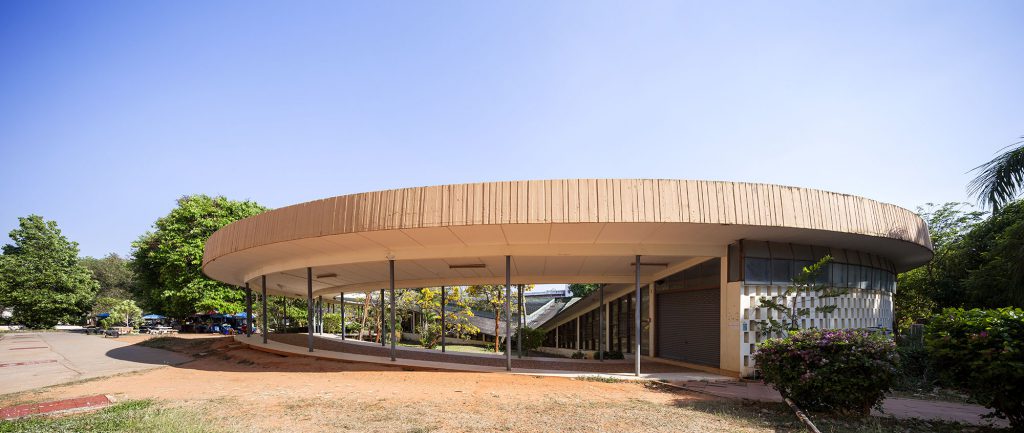
แสงที่ตึกกลมนั้นสวย เป็นความสวยที่ อมร ศรีวงศ์ สถาปนิกผู้ออกแบบอาคารปาฐกถา คณะวิทยาศาสตร์ มหาวิทยาลัยมหิดล ได้พัฒนาขึ้นจากการออกแบบอาคารทรงกลมคณะวิทยาศาสตร์ มหาวิทยาลัยขอนแก่น ที่เขาเคยทำมาก่อน เมื่อ พ.ศ. 2507 ที่ตึกกลม คณะวิทยาศาสตร์ มหาวิทยาลัยขอนแก่น อมรฝังส่วนหนึ่งของอาคารลงไปในดินแล้วทำทางเดินจากภายนอกมุดลงไปใต้ดินเพื่อเข้าสู่ห้องบรรยาย จังหวะการเปลี่ยนผ่านจากภายนอกที่มีความสว่างจ้าไปสู่ภายในที่ค่อนข้างมืดนี้ได้รับการพัฒนาขึ้นอย่างงดงามที่ตึกกลม มหาวิทยาลัยมหิดล เพราะที่นี่การเปลี่ยนผ่านจากสว่างไปสู่มืดไม่ได้เกิดขึ้นอย่างฉับพลัน
หลังจากที่เดินขึ้นบันไดมาแล้วผู้ใช้อาคารจะยังไม่ได้เข้าสู่ห้องบรรยายโดยทันที แต่จะต้องใช้เวลาสักครู่หนึ่งที่ทางเดินรูปวงแหวนบริเวณศูนย์กลางอาคารก่อนเข้าสู่ห้องบรรยาย ณ ใจกลางของที่ว่างแห่งนี้เองที่อมรได้เปิดแสงลงมาจากทางด้านบน ผ่านช่องแสงรูปวงกลมในลักษณะ oculus ทำให้พื้นที่ซึ่งควรจะมืดสุดนั้นกลับไม่มืดทึบ แต่มีแสงสว่างคอยหล่อเลี้ยง สร้างบรรยากาศการเปลี่ยนผ่านจากภายนอกสู่ภายในให้นุ่มนวลขึ้นและมีชั้นเชิง ที่สำคัญคือ ไม่ทำให้เกิดอาการวูบจากการที่สายตาเราปรับตามสภาพแสงไม่ทัน
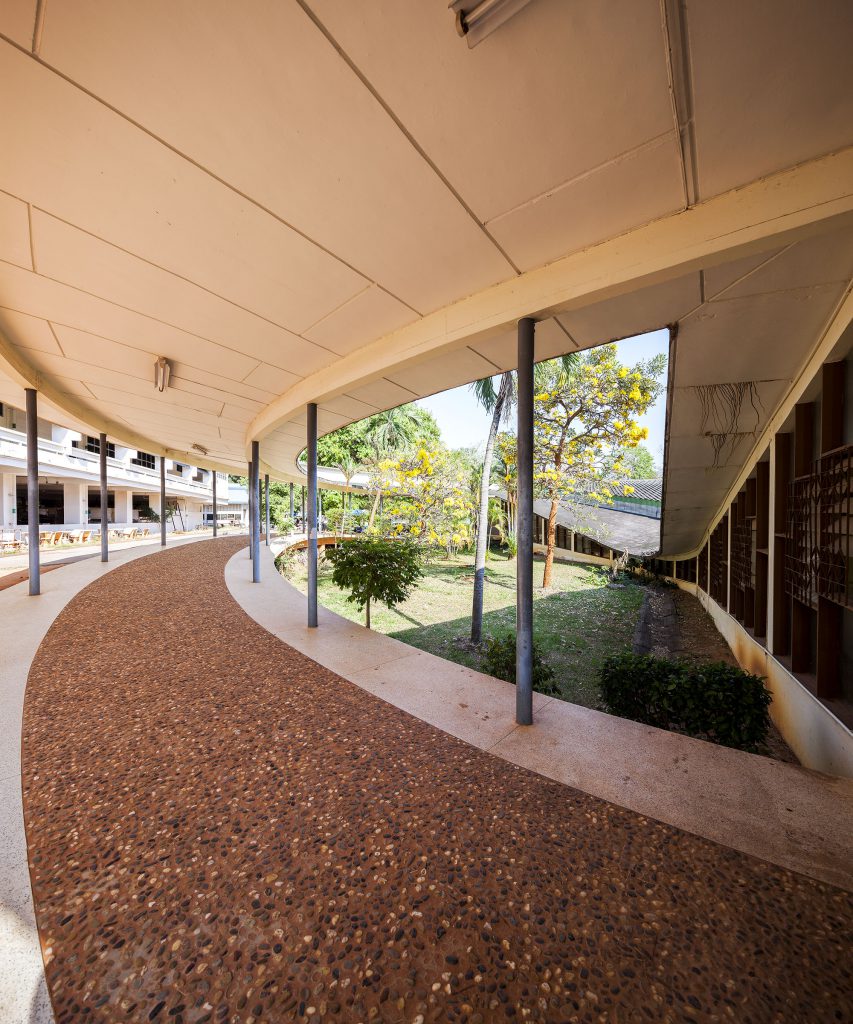
ประเด็นเรื่องแสงที่กล่าวมานี้ คือสิ่งที่บรรดาสถาปนิกที่พอจะมีประสบการณ์สักหน่อยเข้าใจกันอยู่แล้ว แต่แสงอีกลักษณะหนึ่งที่ผมอยากกล่าวถึงในที่นี้ คือแสงในเชิงอุปมาอุปมัย (metaphorical) ซึ่งต้องทำความเข้าใจผ่านการพิจารณาความสัมพันธ์ระหว่างแสง การถ่ายภาพ และคอนกรีต นักประวัติศาสตร์สถาปัตยกรรมชาวอังกฤษ เอเดียน โฟตี้ (Adrian Forty) กล่าวในหนังสือ Concrete and Culture: A Material History ว่า คอนกรีตและการถ่ายภาพมีจุดกำเนิดและพัฒนาการในห้วงเวลาไล่เลี่ยกัน โดยถือกำเนิดขึ้นในทศวรรษที่ 1830s และพัฒนาขึ้นถึงจุดสูงสุดในปลายทศวรรษที่ 1880s และทั้งคู่ยังเป็นผลลัพธ์ของกระบวนการเนกาทีฟ-โพสิทีฟ (a negative-positive process) เช่นเดียวกัน
กล่าวคือในการถ่ายภาพ ช่างภาพต้องนำฟิล์มซึ่งมีเยื่อไวแสงตรงข้ามกับสีของวัตถุออกมารับแสงผ่านกล้องถ่ายภาพ โดยแสงจากคนหรือวัตถุจะถูกบันทึกไว้บนแผ่นฟิล์มในลักษณะที่เรียกว่าเนกาทีฟ จากขาวกลายเป็นดำ และจากดำจะกลายเป็นขาว ส่วนที่สว่างในความเป็นจริงนั้นเมื่อปรากฏบนฟิล์มจะดูมืด ส่วนที่มืดจะดูสว่าง กระทั่งเมื่อนำฟิล์มไปอัดขยายจึงได้ภาพที่มีสีตรงกับความเป็นจริงตามที่ตาเห็น

ฉันใดก็ฉันนั้นกระบวนการของคอนกรีตก็ทำนองเดียวกัน ขั้นแรกต้องทำไม้แบบ (formwork) ขึ้นมา จากนั้นจึงเทคอนกรีตเหลวลงในไม้แบบ ทิ้งให้แห้งได้ที่แล้วจึงถอดไม้แบบออก รูปร่างของคอนกรีตที่เกิดจากกระบวนการหล่อนี้ คือรูปหล่อโพสิทีฟจากไม้แบบเนกาทีฟ การขึ้นไม้แบบจึงถือเป็นกระบวนการที่มีความสำคัญต่อการก่อรูปและพื้นผิวของคอนกรีตที่จะเกิดขึ้นตามมาทันทีจากการหล่อนั้น ยิ่งหากเป็นกรณีของคอนกรีตเปลือยด้วยแล้ว สถาปนิกยิ่งต้องใส่ใจกับการวางตัวของไม้แบบ เพราะในขณะที่ลงมือหล่อ พื้นผิวด้านในของไม้แบบจะถูกบันทึกติดแน่นจนกลายเป็นพื้นผิวด้านนอกของคอนกรีต อันเป็นองค์ประกอบที่ไม่สามารถเปลี่ยนแปลงได้อีกหากคอนกรีตนั้นแข็งตัวไปแล้ว
สถาปนิกที่ต้องการทำอาคารคอนกรีตเปลือยจึงจำเป็นต้องมีความเข้าใจในกระบวนการเนกาทีฟ-โพสิทีฟ ไม่ต่างจากช่างภาพที่ต้องรู้จักเลือกสีฟิวเตอร์ให้เหมาะสมกับการถ่ายภาพขาวดำ อย่างไรก็ตามในขณะที่การถ่ายภาพนั้นใช้ทักษะความรู้เรื่องโทนสีและความสว่างของแสง การหล่ออาคารคอนกรีตเปลือยก็จำเป็นต้องเข้าใจในแม่พิมพ์และรูปหล่อ (mould and cast) ซึ่งในบรรดาสถาปนิกไทยยุคหลัง พ.ศ. 2500 เป็นต้นมา น้อยคนนักที่จะสามารถเล่นกับความเป็นเนกาทีฟ-โพสิทีฟของคอนกรีตได้อย่างสร้างสรรค์เฉกเช่นอมร ศรีวงศ์ โดยเฉพาะคอนกรีตที่ตึกกลม คณะวิทยาศาสตร์ มหาวิทยาลัยมหิดล พญาไท นั้น ต้องนับว่าเป็นการตกผลึกในเรื่องนี้อย่างแท้จริง

ดังที่กล่าวแล้วว่า ที่มหาวิทยาลัยขอนแก่น อาคารปาฐกถาได้รับการออกแบบให้วางตัวฝังลงไปในดินส่วนหนึ่ง ซึ่งอมรได้ใช้พื้นดินที่โอบล้อมอาคารนั้นเป็นไม้แบบสำหรับหล่อพื้นอาคารไปในตัว ขณะที่มหาวิทยาลัยมหิดล อมรได้ออกแบบตึกกลมเป็นรูปชามท้องลึกที่ลอยตัวเหนือลาน sunken ด้านล่าง โดยคอนกรีตรูปชามท้องลึกนี้หล่อขึ้นจากไม้แบบที่ได้รับการจัดวางแพทเทิร์นตามแนวรัศมีพุ่งเข้าหาศูนย์กลางอย่างค่อนข้างพิถีพิถัน
จากภาพถ่ายอาคารขณะกำลังก่อสร้าง จะเห็นว่าการวางไม้แบบเรียงตามแนวรัศมีพุ่งเข้าหาศูนย์กลางทำให้เกิดช่องว่างรูปลิ่มสามเหลี่ยมระหว่างไม้แบบแต่ละแผ่นเสมอ และมีการใช้เศษไม้อุดร่องช่องว่างดังกล่าวเพื่อเตรียมพร้อมรองรับการเทคอนกรีต จนเมื่อเทคอนกรีตและปล่อยให้เริ่มเซตตัวในระดับหนึ่งแล้ว จึงถอดเศษลิ่มไม้เหล่านั้นออก เพื่อปล่อยให้เนื้อคอนกรีตค่อย ๆ ปลิ้นตัวออกมาตามแรงโน้มถ่วงทางร่องที่เว้นไว้ สิ่งที่เกิดขึ้นเมื่อคอนกรีตแข็งตัวคือครีบปูนที่ทิ้งร่องรอยไว้บนท้องฝ้า ซึ่งทำหน้าที่เป็นบัวหยดน้ำควบคุมทิศทางการไหลของน้ำฝน ขณะเดียวกันยามเมื่อครีบปูนเหล่านี้ต้องแสงก็ทำให้เกิดแพทเทิร์นของแสงเงาที่ส่งเสริมลักษณะทางประติมากรรมของอาคารให้เฉิดฉายเปล่งประกาย โดยไม่จำเป็นต้องตกแต่งประดับประดาด้วยวิธีการอื่นใดเพิ่มเติม

การออกแบบไม้แบบหล่อคอนกรีตที่นำมาสู่ผลลัพธ์ทางสถาปัตยกรรมที่สวยสดงดงามนี้ ยังพบได้ในงานออกแบบชิ้นอื่น ๆ ของอมร ศรีวงศ์ด้วยเช่นกัน ไม่ว่าจะเป็นหอส่งสัญญาณวิทยุ คณะวิศวกรรมศาสตร์ มหาวิทยาลัยสงขลานครินทร์, หอสูงเก็บน้ำ คณะพาณิชยกรรมศาสตร์และการบัญชี มหาวิทยาลัยธรรมศาสตร์ และหอสูงเก็บน้ำ มหาวิทยาลัยศิลปากร วิทยาเขตสนามจันทร์ ซึ่งทั้งหมดนี้นอกจากแสดงให้เห็นทักษะทางการออกแบบสถาปัตยกรรมอย่างชนิดหาตัวจับยากแล้ว ยังแสดงถึงความเข้าใจในความเป็นเนกาทีฟ-โพสิทีฟของกระบวนการทางคอนกรีตของผู้ออกแบบอย่างลึกซึ้ง
เพราะหากพินิจเทคนิคการหล่อคอนกรีตที่ตึกเหล่านี้ เราจะต้องฉงนว่า สิ่งใดกันแน่คือองค์ประกอบเนกาทีฟ และสิ่งใดคือโพสิทีฟ ใช่หรือไม่ว่าไม้แบบคือเนกาทีฟ ส่วนอาคารคอนกรีตที่ได้รับการหล่อขึ้นมาคือโพสิทีฟ หรือแท้จริงแล้วทุกอย่างกลับตาลปัตรกัน ไม่บ่อยครั้งนักที่เราจะพบว่า ในบรรดาผลงานสถาปัตยกรรมยุคหลัง พ.ศ. 2500 ของไทย งานสถาปัตยกรรมชิ้นเดียวกันจะสร้างประเด็นคำถามเรื่องแสง การถ่ายภาพ และคอนกรีต ให้เกิดขึ้นได้พร้อม ๆ กัน
The light at Tuek Klom is always gorgeous, and it is as gorgeous as Amorn Srivongse, the architect of the Lecture Building (informally called Tuek Klom) at the Faculty of Science, Mahidol University, which had developed from another lecture building he previously designed in 1964 for the Faculty of Science, Khon Kaen University.
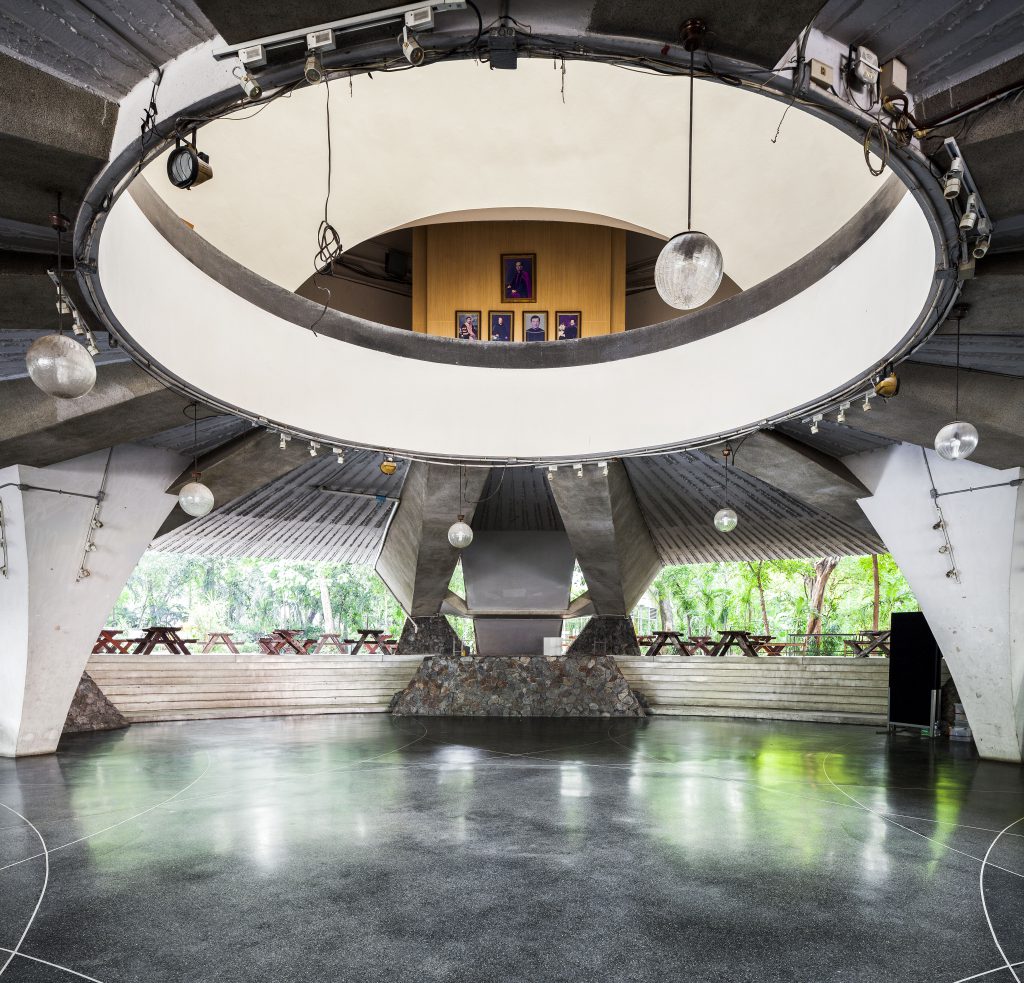
At Khon Kaen University, Amorn buried a portion of the building into the ground and created an underground walkway that leads visitors coming into the building from the outside and into the lecture hall. The sequence of the transitions from the brightly lit outside environment into the rather dark interior space is a beautifully developed design he did with the Lecture Building at the Faculty of Science, Mahidol University.
There, a shift from brightness to darkness isn’t immediate. After walking up the stairs, visitors are not directly led into the lecture hall, but need to spend a bit of an extra time at the circular walkway at the center of the building before finally entering the lecture rooms. At the center of the interior program, Amorn designed for the light to come through the oculus, making the space that would have otherwise been the darkest to be brightened up with the right amount of natural light from above. Such a smooth transition from the exterior to the interior prevents any unpleasant effect that a sudden change of exposure to different lighting conditions might bring to users’ spatial experience.

These light-related issues are what most experienced architects would understand. But there is another type of light I wish to talk about in this article, and that is metaphorical light, which needs to be understood through an exploration into the relationships between light, photography and concrete. Adrian Forty, a British architectural historian, said in the book ‘Concrete and Culture: A Material History’ that concrete and photography both originated in a relatively close time period, which was around the 1830s before the developments reached a peak in the 1980s. What the two inventions have in common is that they are both a result from negative-positive processes.
In photography, a photographer basically uses a camera to capture an object on a film whose light-sensitive material renders a reaction to the opposite colors of the object. When exposed to light, an object or a person is photographed on the film as a ‘negative’ image, for example, white appears as black and vice versa. The bright part, when on film, appears dark, and the dark portion looks bright. When developed on a photographic paper, the negative delivers a positive image, which matches the object’s actual colors seen by one’s bare eyes.
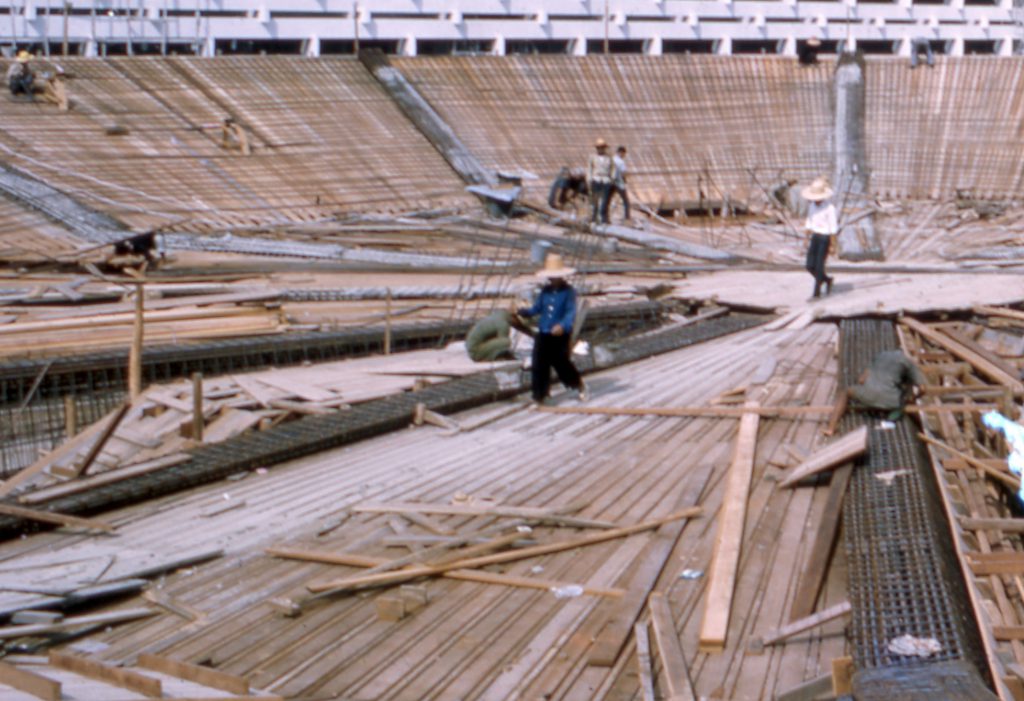
Like photography, concrete similarly lends itself to this kind of positive-negative process. The formwork is first created, and the wet concrete mixture is poured into the mold. When left to dry, the mold is taken off with the final result being a solid concrete form. This particular casting process creates a positive concrete mass out of a negative mold, which means the making of formwork is a crucial step in the casting process for it contributes to the formation of both the shape and texture of a concrete mass. In the case of exposed concrete, an architect is required to be extra attentive to how a formwork is designed and built, for as the casting process is carried out, the inner part of the formwork will imprint itself on the outer surface of the concrete, creating permanent textural details when the concrete becomes dry and solidified.
Architects who work on buildings with the use of exposed concrete need to understand the negative-positive process just like how photographers know which is the right filter to use with black and white photography. Nevertheless, while photography requires a photographer’s skills and knowledge in color tones and brightness of light, the casting process of exposed concrete parts for a building calls for architects’ understanding in how molds and casts work. Among the post-1957 architects in Thailand, few have been able to play around with the negative-positive process of concrete casting better than Amorn Srivongse, especially with the Lecture Building at the Faculty of Science, Mahidol University, Phayathai Campus, the work, which is a testament of a profound crystallization of his idea and knowledge.
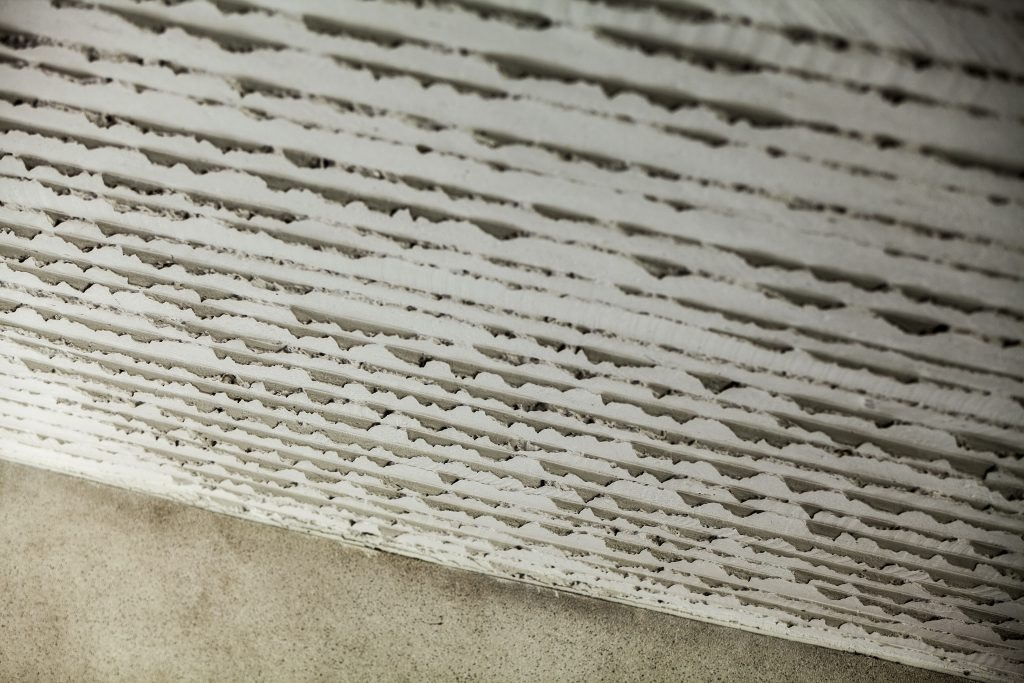
As mentioned, the Lecture Building at Khon Kaen University is designed with a part of its structure buried into the ground, Amorn utilized the ground surrounding the building as the formwork for concrete pouring. Meanwhile, for the Lecture Building at Mahidol University, he designed the building in the shape of a deep bowl concrete structure, elevated above the sunken plaza. The concrete bowl structure was cast using temporary wooden formwork with calculated patterns.
The photographs taken when it was under construction show that each wooden panel was oriented into radial lines pointing toward the center, consequently creating a series of triangular wedges between every adjacent wood panels. Wood scraps were placed to close the gaps, in preparation as the formwork for the concrete pouring process. Once the concrete was poured and left to set to a certain level, the wooden wedges were removed, allowing gravity to push the concrete towards the gaps that were left open. The final result after the concrete was left to its solid state is the fin-like details found on the ceiling, which function as the molding that helps rainwater flow in the proper direction. At the same time, these concrete fins, when exposed to light, render varying patterns of light and shadow, accentuating the building’s sculptural features to be even more eminent and visually striking without the need for other ornamental elements.
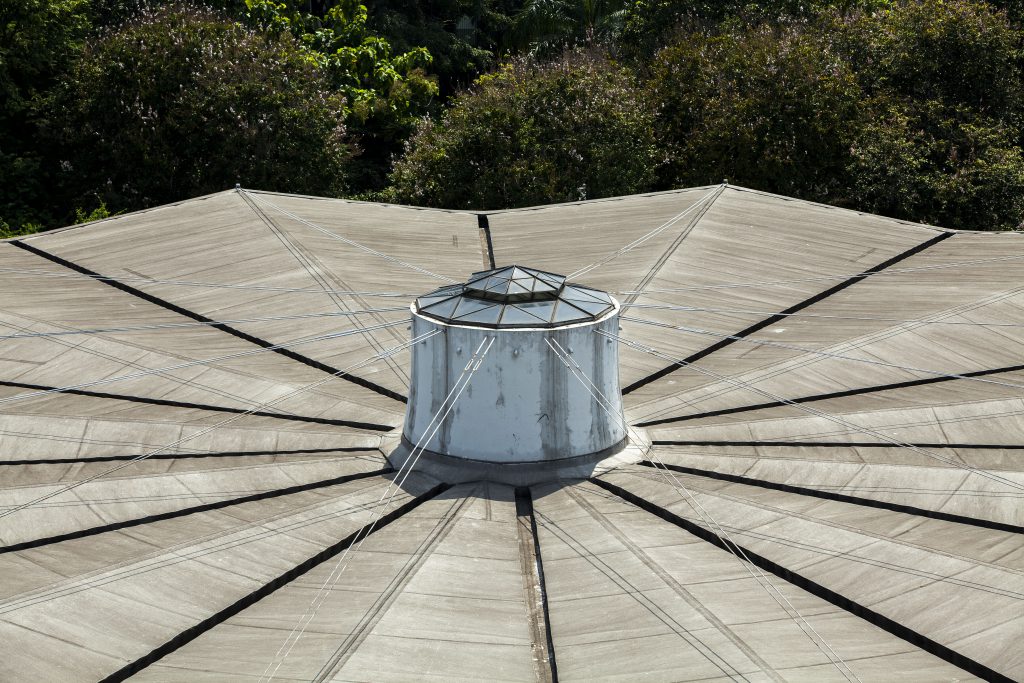
Amorn Srivongse’s masterful use of formwork creates a number of incredible works of architecture such as the Radio Tower at the Faculty of Engineering, Prince of Songkla University, the water storage towers at the Faculty of Commerce and Accountancy at Thammasat University, and Silpakorn University’s Sanamchan Campus. All of which do not only manifest Amorn’s remarkable skills and vision in architectural design, but also demonstrates his extensive knowledge in the negative-positive process of concrete molding and casting. Looking into the techniques developed and devised for the construction of these buildings, most people must be puzzled, wondering which elements are the negative and positive elements? Is the wooden formwork the negative and the concrete form the positive? Or, questioning, in fact, if everything is actually reversed?
Among the post-1957 architectural creations, it isn’t often that we’re able to find the type of buildings from which some thoughtful conversations about light, photography and concrete emerge simultaneously, in the way and to the extent that has been achieved by Amorn’s works.

